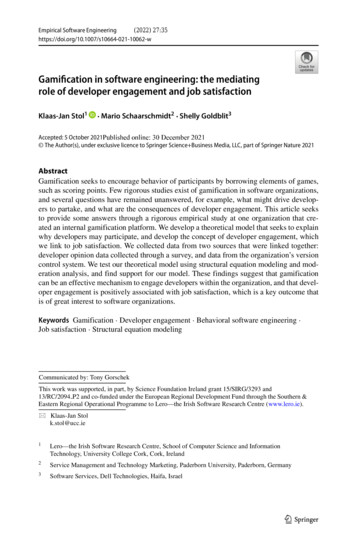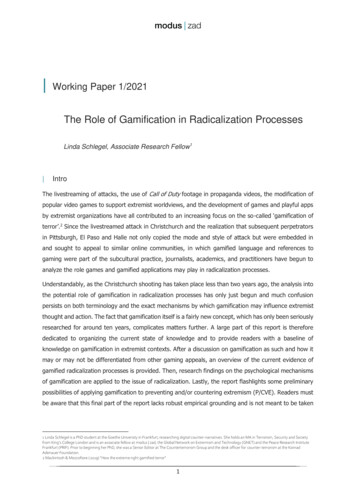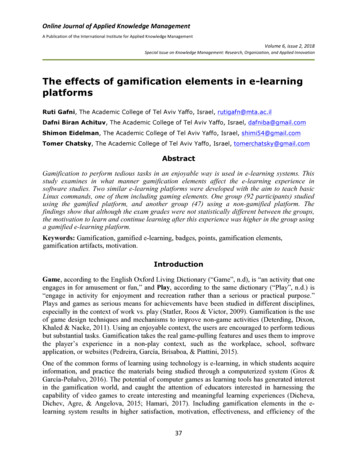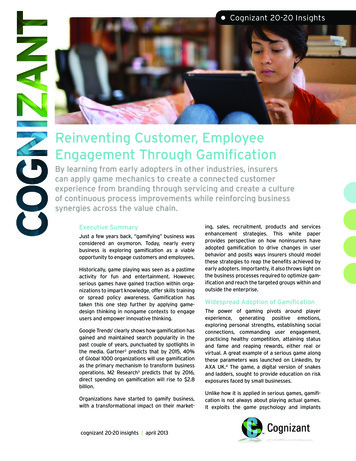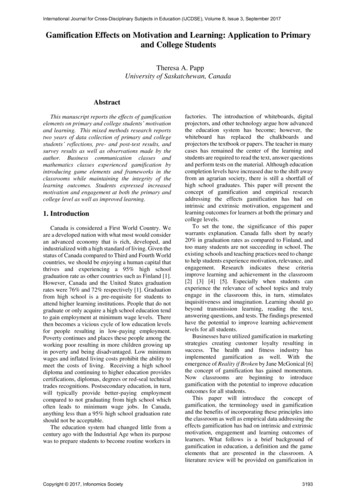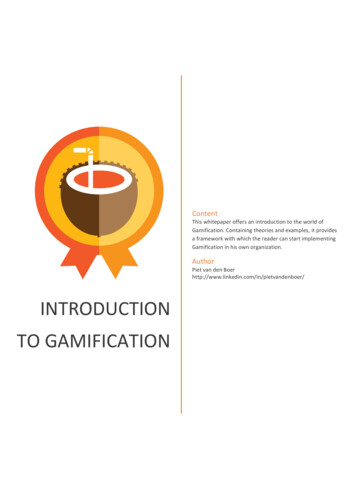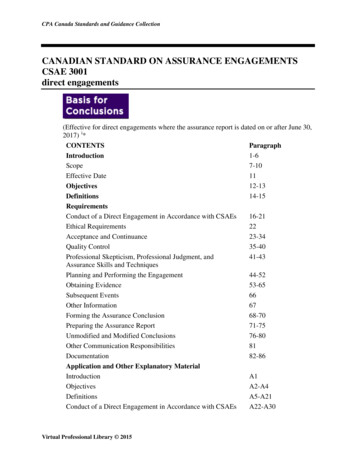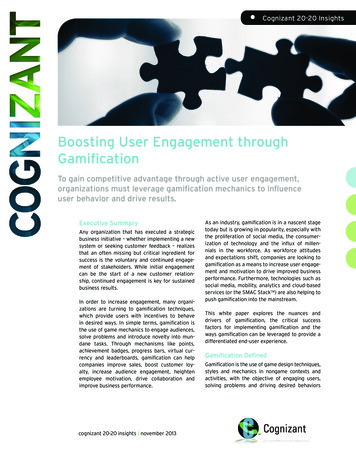
Transcription
Cognizant 20-20 InsightsBoosting User Engagement throughGamificationTo gain competitive advantage through active user engagement,organizations must leverage gamification mechanics to influenceuser behavior and drive results.Executive SummaryAny organization that has executed a strategicbusiness initiative – whether implementing a newsystem or seeking customer feedback – realizesthat an often missing but critical ingredient forsuccess is the voluntary and continued engagement of stakeholders. While initial engagementcan be the start of a new customer relationship, continued engagement is key for sustainedbusiness results.In order to increase engagement, many organizations are turning to gamification techniques,which provide users with incentives to behavein desired ways. In simple terms, gamification isthe use of game mechanics to engage audiences,solve problems and introduce novelty into mundane tasks. Through mechanisms like points,achievement badges, progress bars, virtual currency and leaderboards, gamification can helpcompanies improve sales, boost customer loyalty, increase audience engagement, heightenemployee motivation, drive collaboration andimprove business performance.cognizant 20-20 insights november 2013As an industry, gamification is in a nascent stagetoday but is growing in popularity, especially withthe proliferation of social media, the consumerization of technology and the influx of millennials in the workforce. As workforce attitudesand expectations shift, companies are looking togamification as a means to increase user engagement and motivation to drive improved businessperformance. Furthermore, technologies such associal media, mobility, analytics and cloud-basedservices (or the SMAC Stack ) are also helping topush gamification into the mainstream.This white paper explores the nuances anddrivers of gamification, the critical successfactors for implementing gamification and theways gamification can be leveraged to provide adifferentiated end-user experience.Gamification DefinedGamification is the use of game design techniques,styles and mechanics in nongame contexts andactivities, with the objective of engaging users,solving problems and driving desired behaviors
that help the company reach a business goal,whether it is cutting costs, increasing performance, improving customer satisfaction or devising innovative solutions.1, 2 By making technologyinteractive, gamificaGamification is the moretion can also enliven munprocess of using dane,business-as-usualgame dynamics to activities, including completfeedback surveys, underengage audiences inggoing training, learning andand solve problems. collaborating.times and real-time feedback.3 Gamification leverages the information derived through real-timefeedback and uses those insights to reinforcedesired behavior.For instance, gamification speeds up positive feedback loops between managers anddirect reports. Associates can obtain immediatefeedback from managers rather than waiting foryear-end or quarterly reviews. Real-time feedbackalso enables valuable customer opinions to beobtained to accelerate marketing launch cycles.For instance, training can be gamified by incorporating difficulty levels to encourage learningcompletion. Fast-track learners can be rewardedwith public recognition or other awards, and theycan also be encouraged to train other membersto gain additional awards. Similarly, customerscan be encouraged to provide feedback or makerepeat visits through the provision of goodies orpromotional offers.Applying GamificationIndustry analysts predict rapid adoption ofgamification. By 2014, more than 70% of Global2000 organizations will have at least onegamified application, according to Gartner, Inc.,and 25% of day-to-day business processes willuse aspects of gamification.4According to Gabe Zichermann, founder and CEOof Gamification Co., over 350 companies havelaunched major gamificationprojects, including consumer By 2014, morebrands like MLB, Adobe, NBC,than 70% ofWalgreens, Ford, Southwest,eBay, Panera and Threadless, Global 2000as well as B2B companies like organizationsOracle, SAP, Jive, Cisco, Pearwill have at leastson and Salesforce. For thesecompanies, he says, “gami- one gamifiedfication has emerged as a application,key element in their consumaccording toerization of the enterprisestrategy.” Further, he says, in Gartner, Inc., and2012 to 2013 alone, consulting 25% of day-to-daybehemoths Deloitte, Accenbusiness processesture, NTTData and Capgeminibegan practices targeting will use aspects ofgamification of Fortune 500 gamification.companies.5 This affirmsthe growing adoption of gamification by organizations across the world to help solve problems.Organizations typically deploy gamification forthe following reasons: Ensure program success by driving organizational behavior change. Motivate audiences to voluntarily participatein mundane tasks. Increase participation in work-related trainingand development programs. Encourage performance and innovation. Enhance customer loyalty and employee retention. Obtain valuable customer feedback.In today’s real-time and always-connected world,our reaction times and attention spans have contracted. Most people have grown accustomed toready access to information, sub-second responseGamification of the Contact CenterResolutionsQuickResolutionsHappy CustomersScoreEmployee 12011893Employee 2155975Employee 3115761LeaderboardSource: Cognizant Technology SolutionsFigure 1cognizant 20-20 insights2
Today, specific process areas or functions areleveraging gamification techniques to meet theirobjectives. For instance, conAn emerging use tact centers and customerorganizations areof gamification serviceusing leaderboards to driveis to drive performance among contactcompetitiveness center agents or devisinggames to increasethrough the racingthe number of closed tickcreation of ets per agent. These gamiprofit centers. fication solutions rewardagents who meet their targets and display the results on a publicly visibleleaderboard (see Figure 1, previous page). In thisexample, “Resolutions” indicate the total numberof resolved tickets; “Quick Resolutions” indicatethe number of tickets closed within the target service level agreement or goal; and “Happy Customers” indicates the number of tickets that receivedpositive customer feedback. The goal is to drivefaster business results by motivating contact center agents to perform better through public recognition of their achievements, ultimately leadingto greater customer satisfaction.Another high-impact application for gamification is an IT transformation initiative whosesuccess depends on effective organizationalchange. Because such initiatives involve process change or technology enhancements, theyrequire a significant effort to change user behavior. An example is a program involving a migrationfrom Lotus Notes to Exchange. Gamified training could be launched to help users undergo ademonstration of the new e-mail platform andtake different levels of challenges to learn andadopt its new features. Fast learners can berewarded and encouraged to help other users getequipped, as well.Three Levels of Value GenerationWe see gamification being applied to meet threeprimary objectives: Cost optimization: Gaining a cost advantage isa primary driver for gamification. For instance,a leading hospitality company has usedgamified online learning courses to reducetraining and development costs. Organizationscan also gamify health and wellness campaignsto control employee healthcare costs.Influencing emotion: The next level of engagement is the emotional or personal aspect.cognizant 20-20 insightsThe services industry relies heavily on theresponsiveness of people and the relationshipsthey form. This aspect is well exploited bythe media and entertainment industry, whichgenerates simultaneous/instantaneous feedback loops to drive sales and boost customermorale. This can also be seen in organizationsthat use employee feedback and reviews toboost morale in the form of public recognition,rewards, points, etc. Innovation: An emerging use of gamification isto drive competitiveness through the creationof profit centers. For instance, a leading technology and consulting company has developeda game-based business performance management simulator that has spawned several B2Bproducts and has become the company’s toplead generator.6Getting Gamification RightThere are as many ways to approach gamificationas there are ways to get it wrong. In fact, according to Gartner, 80% of gamified applicationswill fail to meet business objectives due to poordesign.7A common design mistake is failing to build indrivers that sustain user interest in the gamifiedapplication. For instance, the launch of a gamified CRM platform designedto help generate leads can Gamification cancontinue to do so only if theinspire a suddenfeedback is measured andconveyed to the audience spike in userso they realize the conse- interest withquences of their actions andeven the mostbehave in a desired manner.Gamification can inspire a rudimentarysudden spike in user interest game elements;and drive immediate resultshowever, if thewith even the most rudimentary game elements, such as audience does notpoints, badges and leader- realize value inboards; however, if the audithe long term, theence does not realize valuein the long term, the engage- engagement beginsment begins to break down. to break down.Another risk is unintended consequences.Because individuals are motivated in different ways and at different levels, gamificationcan introduce undesirable user behavior thatdoes not align with business goals. For example,while the public recognition provided through3
leaderboards might motivate one individual, itmay not appeal to others who dislike too muchattention. Organizations need to be aware of individual motivations when determining reward systems of a game.in mundane or traditionalprocesses; it also needs toadd a fun element to theseprocesses. For instance,while typical gamification components includebadges, levels, challengesand players, these can besubstituted with rewards,achievements,ranks,tests, avatars and anyother element that wouldattract the audience andmatch its motivation level.Feedback is another area in which basicuser experience guidelines need to be established. Generally, feedback needs to bebalanced, well-timed and continual. Too muchfeedback can be frustrating to users and mayprove futile, while too little feedback can result indwindling user interest.To ensure desired results, four key designelements should be included in any gamificationplatform (see Figure 2): Objective: Pursuing a gamification initiativewithout a stated objective is a prescriptionfor failure, as these applications are intendedto address a business problem. A questionthat can help define the business objective is,“What is missing in current behaviors?”Target audience: Identifying and definingthe target audience is also very important.Keeping this audience in mind is critical toincorporating the most effective nuancesin the gamification platform for continuousaudience engagement.Innovation: Gamification is not only aboutcreating and implementing gaming mechanics Justification: Finally, users need a compelling reason to begin engaging with the gamification element and continue to do so overtime. Without user participation, the intendedoutcomes will not be realized.Other activities – such as benchmarking currentperformance, quantifying results and being prepared to modify or revisit the original assumptions and rules – are all indispensable for gamification success. The gamification idea needs to bethought through for long-term results, and tradeoffs need to be made between the difficulty leveland simplicity of the gamification mechanics.The Way ForwardImplementing gamification mechanics extendsbeyond rewards and badges. Organizationsneed to apply their gamification efforts towardFour Key Gamification vationSource: Cognizant Technology SolutionsFigure 2cognizant 20-20 insightsThe gamificationidea needs to bethought throughfor long-termresults, andtrade-offs need tobe made betweenthe difficulty leveland simplicity ofthe gamificationmechanics.4TargetAudience
achieving a business goal that requires voluntaryaudience participation and engagement to yieldresults. Furthermore, they need to take a holisticview of adding a fun element to otherwise mundane activities. Rather than look for immediatebenefits, companies should aim for long-term,sustainable results.Secondly, the behavioral changes that gamification inspires cannot be superficial. Theseinitiatives require a mindset change and a culture shift across the organization, which requiresenterprise-level commitment. Particularly whengamification is combined with technologiessuch as the SMAC Stack, it is bound to disrupttraditional operations.Third, gamification needs to be designed andthought through, from inception to implementation. The audience needs a compelling reasonto keep coming back and stay engaged on a continual basis, or gamification might fail to achieveits desired results.Finally, as long as gamification drives the desiredsustainable behavior, it willfulfill its untapped potentialto provide a differentiatedend-user experience.Organizationsmust rememberthat usinggamification todrive sustainablebehaviorchanges is not ashort-term goal.With emerging solutions likethe SMAC Stack transforming business, IT organizations should look for packaging gamification mechanics as an integratedsolution for faster cloud-based model adoptionand sustained engagement. To continuouslyprovide a unique, customized experience toemployees or customers, organizations needto be on a constant look-out for gamificationdynamics affecting their industry and evaluatehow they can use gamification to better innovate,better connect and better empower users.Footnotes1“12 Startling Gamification Stats,” Ryan Jenkins blog, ification-stats/.2Peter Wannemacher, “Read This Blog, Win a Prize,” Forrester Research, Inc. blog, May 31, 2012,http://blogs.forrester.com/peter wannemacher/12-05-31-read this blog win a prize.3Michael Hugos, Enterprise Games: Using Game Mechanics to Build a Better Business, CreateSpaceIndependent Publishing Platform, July 17, 2013.4“Gartner Predicts Over 70% of Global 2000 Organizations Will Have at Least One GamifiedApplication by 2014,” Gartner, Inc., Nov. 9, 2011, http://www.gartner.com/newsroom/id/1844115.5Bryant Nielson, “Measuring the Effectiveness of Gamification,” Your Training Edge, June 13, -effectiveness-of-gamification/#more-1494.6Gabe Zichermann, ”Beyond the Hype: Five Ways that Big Companies Are Using Gamification,” GigaOm,Jan. 27, 2013, rtner Says by 2014, 80% of Current Gamified Applications Will Fail to Meet Business ObjectivesPrimarily Due to Poor Design,” Gartner, Inc., Nov. 27, 2012, nt 20-20 insights5
References Jarod Greene, “Engaging Your IT Service Desk With Gamification,” Gartner, Inc., Nov. 3, 2011. Nitesh Ambuj, Shahnawaz Khan, “Enterprise Gamification,” Happiest Minds, Social ComputingPractice, April 2012, nterprise-Gamification.pdf Gamification.Co Web site, http://www.gamification.co/gabe-zichermann/.Brian Burke, “Gamification 2020: What Is the Future of Gamification?” Gartner, Inc., Nov. 5, 2012.Jarod Greene, “The Implications of Gamification on IT Operations,” Gartner, Inc., Aug. 7, 2012.Bill Chamberlin, “Gamification: A 2013 Horizon Watching Trend Report,” Horizon Watching, March 22,2013, http://ww.billchamberlin.com/2013/03/.Badgeville Web site, www.badgeville.com/.Melissa Jun Rowley, “A Gamified Cloud in 2013,” Cisco, Jan. 7, 2013, d 1122331&type webcontent. “Gamification,” HP Technology at Work, October 2012, -. “Enterprise Gamification: Beyond the Badges (and the Hype),” Kwench, May 20, 2013, cation-beyond-the-badges-and-the-hype/. “Global Gamification Market 2012-2016,” Technavio, Nov. 26, 2012, on-market-2012-2016. Kris Duggan, “2013: The Year of Gamification,” Business News Daily, Jan. 15, 2013, -gamification.html.About the AuthorLitisa Senapati is a Senior Consultant in the technology office within Cognizant’s IT IS Practice,helping customers recognize tangible benefits by implementing transformation themes and initiatives. Her areas of expertise include infrastructure consulting and IT strategy. Litisa has eight years invarious IT functions, including operations, consulting and architecting solutions, and holds a postgraduate diploma in business management and a bachelor’s degree in engineering from Birla Instituteof Technology. She can be reached at Litisa.Senapati@cognizant.com.About CognizantCognizant (NASDAQ: CTSH) is a leading provider of information technology, consulting, and business processoutsourcing services, dedicated to helping the world’s leading companies build stronger businesses. Headquarteredin Teaneck, New Jersey (U.S.), Cognizant combines a passion for client satisfaction, technology innovation, deepindustry and business process expertise, and a global, collaborative workforce that embodies the future of work.With over 50 delivery centers worldwide and approximately 164,300 employees as of June 30, 2013, Cognizant is amember of the NASDAQ-100, the S&P 500, the Forbes Global 2000, and the Fortune 500 and is ranked among thetop performing and fastest growing companies in the world.Visit us online at www.cognizant.com for more information.World HeadquartersEuropean HeadquartersIndia Operations Headquarters500 Frank W. Burr Blvd.Teaneck, NJ 07666 USAPhone: 1 201 801 0233Fax: 1 201 801 0243Toll Free: 1 888 937 3277Email: inquiry@cognizant.com1 Kingdom StreetPaddington CentralLondon W2 6BDPhone: 44 (0) 207 297 7600Fax: 44 (0) 207 121 0102Email: infouk@cognizant.com#5/535, Old Mahabalipuram RoadOkkiyam Pettai, ThoraipakkamChennai, 600 096 IndiaPhone: 91 (0) 44 4209 6000Fax: 91 (0) 44 4209 6060Email: inquiryindia@cognizant.com Copyright 2013, Cognizant. All rights reserved. No part of this document may be reproduced, stored in a retrieval system, transmitted in any form or by anymeans, electronic, mechanical, photocopying, recording, or otherwise, without the express written permission from Cognizant. The information contained herein issubject to change without notice. All other trademarks mentioned herein are the property of their respective owners.
the growing adoption of gamification by organiza-tions across the world to help solve problems. By 2014, more than 70% of Global 2000 organizations will have at least one gamified application, according to Gartner, Inc., and 25% of day-to-day business processes will use aspects of gamification. Gamif

